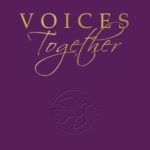This article is part of our series on Voices Together, a new worship and song collection coming fall 2020 from MennoMedia, in partnership with Mennonite Church USA and Mennonite Church Canada.
 Sarah Kathleen Johnson is the worship resources editor for Voices Together and the editor of the Voices Together: Worship Leader Edition. Originally from Waterloo, Ontario and currently based in Toronto, she is completing a PhD in theology at the University of Notre Dame.
Sarah Kathleen Johnson is the worship resources editor for Voices Together and the editor of the Voices Together: Worship Leader Edition. Originally from Waterloo, Ontario and currently based in Toronto, she is completing a PhD in theology at the University of Notre Dame.
Many congregations have pre-ordered Voices Together — far more than MennoMedia expected by this time. This astonishing level of concrete support and trust is humbling and overwhelming for those of us who have worked on this hymnal and worship book over the past four years.
There are also congregations who are still in the process of deciding whether or not Voices Together will shape their worship in the years ahead. As the worship resources editor, I am a huge supporter of Voices Together and believe this book can serve a broad range of congregations. At the same, I can think of at least three good reasons why a church should not get a congregational set of Voices Together:
Three good reasons NOT to get Voices Together
- Your primary language of worship is not English. While Voices Together aims to include all of the languages spoken in worship in Mennonite Church Canada and Mennonite Church USA congregations, among other languages, it simply does not include enough material in any language other than English to support a robust worship life. For example, Spanish is the second largest body of material with 49 songs, which is still not adequate to support a community that worships only in Spanish.
- You do not worship with a hymnal. There are lots of great ways to worship that do not involve a hymnal. Some communities learn songs by ear or project lyrics on a screen. If your community is fostering vibrant congregational singing without books, keep doing what you are doing!
- Your congregation anticipates a major transition in the next couple of years. If your congregation is on the verge of a merger, closure, or change in denominational affiliation, you have other concerns to attend to right now. It takes time and effort to get to know a new hymnal and worship book — it is an investment that pays off five, ten and twenty years down the road. If your congregation is not going to exist in a couple of years, focus on singing what is already in your hearts and hands.
Even though these are good reasons not to get a congregational set of hymnals, communities in these categories may benefit from a couple of copies of Voices Together, a Worship Leader Edition, and an Accompaniment Edition to use for worship planning purposes. A set of copies for a music team or choir may also be valuable.
I am optimistic that most other communities would benefit from Voices Together. The book includes enough material in a diversity of theological and musical expressions to support a wide range of worship practices. Whatever your starting point, there will be songs and resources that are familiar as well as options for exploring new directions.
This does not mean that every page is a good fit for every congregation. There will be songs and prayers that you should not sing and pray in your community. When you encounter these words and musical expressions, consider how they may support other communities that are part of the Mennonite church, just as words and music that are home for you may not be life-giving for others.
Three bad reasons NOT to get Voices Together
While there are good reasons not to get Voices Together, I have also sometimes heard rumblings of what I would consider bad reasons for not getting Voices Together.
- You love Hymnal: A Worship Book. You are in good company! The Mennonite Worship and Song Committee working on Voices Together loves Hymnal: A Worship Book too, as well as Sing the Journey and Sing the Story. Personally, as I have spent thousands of hours reflecting on and discussing this material with the committee (literally engaging every single song and worship resource multiple times), I have come to love and respect these books all the more. There is continuity between Hymnal: A Worship Book and Voices Together. There is a widely-sung and well-loved common core from the current books that forms the heart of Voices Together. More than half of the material in Voices Together comes from the current books — a higher proportion than Hymnal: A Worship Book carried forward from The Mennonite Hymnal. Even if one or two of your favorite songs are not included, you can still sing them. If you love the blue hymnal, I am optimistic that you are going to love the purple hymnal too.
- You already have too many books. Perhaps you are juggling a hymnal, two supplements, a locally created collection and bulletin inserts. Voices Together aims to include the core of Hymnal: A Worship Book, Sing the Journey, and Sing the Story as well as Contemporary Worship Music that is already widely sung. Voices Together therefore has the potential to streamline the book experience of worshipers, which is especially helpful for newcomers. Although congregations may choose to keep any number of books on carts or fill pew racks to the brim, Voices Together has the capacity to stand alone. If you feel like you already have too many books, this may be the one book for you.
- You are afraid of change. Fear of change is natural. The root of the fear of change is often the fear of losing something. The Mennonite Worship and Song Committee has taken care to listen for what is important to maintain, and there is significant continuity with previous Mennonite hymnals. At the same time, the church is changing and the world is changing. Voices Together provides words for worship and songs that draw on Scripture and tradition to engage current topics such as creation care, aging, mental health, community violence and Indigenous justice. It includes both familiar and new language, theology, musical styles and representations of cultural identities. Change has always happened and will continue to happen. Voices Together is here to help manage change in thoughtful ways.
Of course a range of other factors shape decisions about getting a new hymnal: finances, collaborative decision making processes, musical leadership and more. This summary is not meant to make light of difficult decisions related to a new hymnal, but rather to address some common concerns and questions. If you have questions about Voices Together, feel free to reach out to general editor Bradley Kauffman or local committee members.


